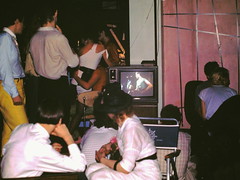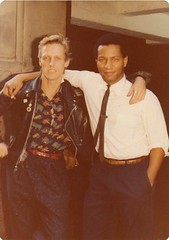Pat Ivers and Emily Armstrong continue sorting through their archives of punk-era concert footage as it’s digitized for the Downtown Collection at N.Y.U.’s Fales Library.
When BAD Burger announced last month that it was ditching its plan to stay open 24/7, it seemed like one more market indicator of the neighborhood’s shifting demographic from boho stronghold to, well, we’re not sure what it is anymore, other than upscale. It got us thinking about how much things have changed from those wild years in the late ’70s and early ’80s when rents were low, charm was currency and after hours clubs were everywhere. The fact that these establishments were blatantly illegal barely furrowed a brow back then. They were just part of the city’s recession economy.
For a lot of people, those early Reagan Years were also the Up All Night Years. Typically, an after-hours spot opened around 3 a.m. and gave up the ghost around noon. Somehow, they were always packed and never too hard to find. Given the variety and sheer number of options available, folks tended to flit from place to place, but clubs did have individual identities. AM/PM in Tribeca attracted a mix of Wall Street types, downtown rockers and artists, while Crisco Disco and the Anvil were for the gay boys on the West Side. The Jefferson was shabby chic, a derelict vaudeville theater and a bit of a death trap; there was only a narrow staircase to the second floor where the festivities sometimes spilled out onto a rickety marquee overlooking East 14th Street. It did have romance: a friend of ours met his first wife there.
Long before the High Line, the Continental over on West 25th Street started attracting some uptown types. Studio 54 had recently closed and celebrities like tennis star Vitas Gerulaitis and regulars like Billy Idol would rub elbows in the ultimate back room, a space called the Loading Dock that was just that: a concrete area where trucks would unload their goods. It was cold but for a variety of reasons, no one seemed to care.
There were others: places like Laight Street, Club 82, Berlin, Brownies, and Save the Robots. There was always one more place to go, a little more trouble to get into, if that was your inclination.
Of them all, only one after-hours club advertised in the Village Voice and booked bands on a regular basis and that was the first Danceteria, circa 1980. Completely illegal, it ran from 10 p.m. to 8 a.m. There were three floors of action, a disco in the basement, performance space on the main floor and on the second floor, the Video Lounge.
We designed and operated the Video Lounge, working as the first regular VJs in a nightclub. We entertained patrons with a mix of found footage, kung-fu movie trailers and our own video collection of the bands we had documented over the years, displaying it all on a network of console t.v. sets with sofas arranged like living rooms.
This was pre MTV days, so you made your own visual fun. Staff members like Keith Haring and David Wojnarowicz, who were working there as bus boys while they made their art, sometimes gave us their video work to show. We also shot the bands, running a video feed between floors so everyone could watch them perform. The acts were scheduled at 1 a.m., 3 a.m. and 5 a.m., two bands a night, usually performing 35 minute sets. Sometimes, the headliners’ last show could start as late as 6 a.m.
Doorman Aleph Ashline remembers, ”By that time most of the door action would be over and we were often able to go in and watch the late set, especially if they were friends like 3 Teens Kill 4 or the Bush Tetras. Their song, ‘Too Many Creeps,’ by the way, was our doorman anthem and great to dance to.”
Which is all the more reason to enjoy a little more Pylon. We got such a great response to them last week, we decided to share a little more of Athens’ finest at Danceteria. Now, remember this performance of “Volume” was shot around 5:45 AM on a very hot and humid night. If you close your eyes, you can feel it. Or stay up really late tonight and play it loud. It’s almost like being there.






